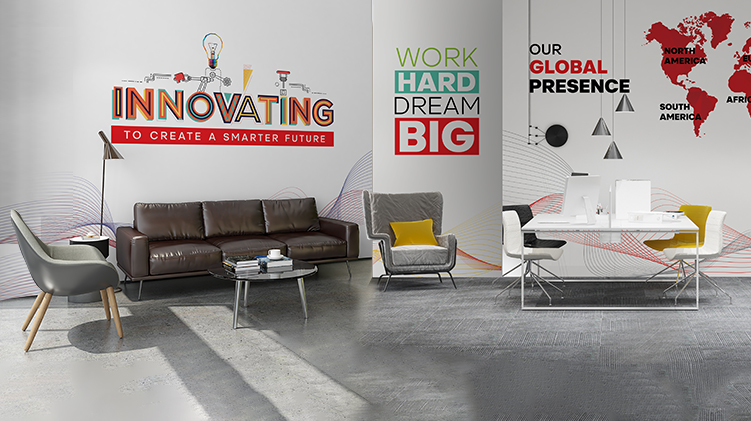

Interior branding: How it will build your corporate identity
The physical space of your business, whether an office or a retail store, is more than just a place to work or sell products. It's a powerful tool for communicating your brand identity and engaging with your target audience. This approach is known as interior branding, and leveraging its potential can significantly enhance your corporate identity.
WHAT IS INTERIOR BRANDING?
Interior branding encompasses the strategic integration of design elements within physical spaces to effectively communicate a brand's ethos, culture, and personality. It transcends mere aesthetics, encompassing everything from the layout and color scheme to the furniture and signage. Essentially, it's about curating an environment that not only mirrors the brand but also resonates with both employees and visitors on a deeper level.
Components of Interior Branding
- Color Palette: Colors wield immense psychological influence, evoking specific emotions and associations. Hence, consistent utilization of brand colors throughout the interior aids in reinforcing brand recognition and identity.
- Typography: Typography plays a pivotal role in interior branding, akin to its significance in graphic design. Choosing fonts that mirror the brand's personality enhances visual consistency and fosters a cohesive experience.
- Graphics and Imagery: From striking murals to digital displays, integrating branded graphics and imagery serves to reinforce core brand messages and values.
- Furniture and Layout: The arrangement of furniture and the overall spatial layout can effectively convey facets of a brand's culture and ethos. For instance, open-plan layouts might signify transparency and collaboration, while private offices may allude to a more hierarchical structure.
WHY BRANDING IS IMPERATIVE IN INTERIOR DESIGN
Effective branding serves as the cornerstone for businesses striving for differentiation and recognition in a saturated market. Here's why interior branding holds paramount importance:
- Consistency: Uniform branding across all touch points, including physical spaces, fosters trust and recognition among both customers and employees.
- Distinctiveness: In a fiercely competitive landscape, a meticulously branded interior aids in setting your business apart from rivals, leaving a lasting impression on stakeholders.
- Employee Engagement: A meticulously designed workspace that mirrors the company's values can significantly enhance employee morale, productivity, and overall satisfaction.
- Customer Experience: The ambiance of a space plays a pivotal role in shaping the customer experience. A branded interior can augment engagement and leave an indelible mark on visitors.
CORPORATE IDENTITY IN OFFICE INTERIORS
Corporate offices serve as the nerve centers of organizations, epitomizing their identity and ethos. Here are key considerations for corporate interior branding:
- Branded Work Spaces: Seamlessly integrate branding elements such as logos, colors, and messaging across office spaces, meeting rooms, and communal areas to craft a cohesive brand narrative.
- Cafe Branding: Design dedicated spaces for collaboration, relaxation, and socialization to foster a sense of community and belonging among employees.
- Branded Signage: Clear and consistent signage not only aids in way finding but also reinforces brand identity at every interaction point.
- Interactive Brand Experiences: Incorporating interactive elements such as digital displays or immersive installations facilitates memorable brand experiences for both employees and visitors.
- Window Branding: Window branding refers to the strategic use of windows as a space for branding and marketing purposes. Whether it's storefront windows, office building windows, or vehicle windows, this form of branding offers a unique opportunity to attract attention, communicate messages, and enhance brand visibility.
- Concept Design: The process of creating initial ideas and visual representations for products, projects, or initiatives. It involves brainstorming, sketching, and refining concepts to communicate the intended vision effectively. Overall, concept designing serves as a crucial stage in the development process, laying the foundation for the subsequent stages of design and implementation.
VISUAL BRANDING IN RETAIL INTERIORS
Retail environments offer unique opportunities for visual branding, directly influencing consumer behavior and perception. Here's how visual branding can be leveraged in retail interiors:
- Window Displays: Compelling window displays reflecting the brand's aesthetic and current promotions serve to attract foot traffic and ignite curiosity.
- In-Store Layout: Strategically placing products, signage, and branding elements guides customers through the store, encouraging exploration and engagement.
- Branded Touch points: From packaging to receipts, every customer interaction should reflect the brand's visual identity and messaging, ensuring a seamless omnichannel experience.
- Sensory Branding: Beyond visuals, consider leveraging other senses such as sound, scent, and texture to evoke emotions and reinforce brand associations.
ELEMENTS TO CONSIDER
When embarking on interior branding initiatives, several key elements warrant consideration for maximum impact:
- Understanding the Audience: A profound comprehension of the preferences and expectations of the target audience enables tailoring of branding elements to resonate effectively.
- Flexibility: Design spaces that possess the agility to adapt to evolving brand strategies and accommodate future growth or shifts in direction.
- Authenticity: Ensure that the interior branding authentically mirrors the values and personality of the brand, steering clear of gimmicks or trends that may dilute brand authenticity.
- Measurement: Establish metrics to gauge the efficacy of interior branding endeavors, be it through employee satisfaction surveys or customer feedback mechanisms.
Conclusion
In summation, interior branding emerges as a potent tool for fortifying corporate identity and fostering brand recognition. By thoughtfully incorporating branding elements into physical spaces, businesses can cultivate environments that not only visually appeal but also resonate profoundly with stakeholders, paving the path for sustained success in today's dynamic business landscape.
For expert guidance on implementing bespoke interior branding strategies tailored to your business requisites, consider partnering with Rishiraj Media Solutions, a trailblazer in innovative branding solutions. With Rishiraj Media at your side, embark on a transformative journey towards crafting immersive interior branding experiences that elevate your corporate identity to unparalleled heights.